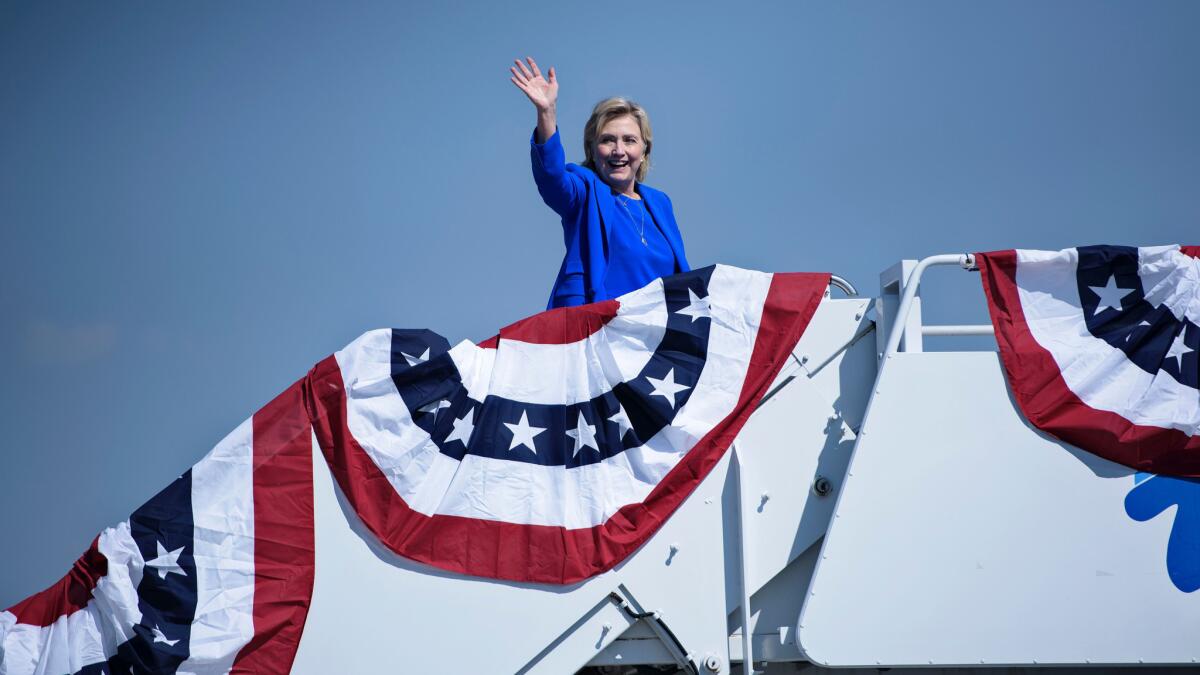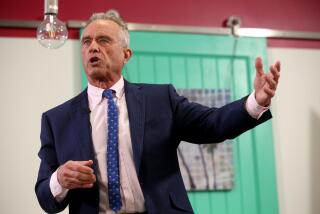Nevada test site: Can Clinton’s top-down organization overcome Trump’s bottom-up enthusiasm?
- Share via
Reporting from Las Vegas — The nerve center of Nevada’s Democratic Party was abuzz with activity, like a dorm room full of grown-ups cramming for the Big Exam.
Dozens of campaign workers, arrayed around a hodgepodge of old furniture, tapped at their laptop computers and murmured into cell phones, a cardboard cut-out of Hillary Clinton standing sentry in the midst of the well-worn office suite.
A few miles away, in a sleek industrial park, Donald Trump’s recently opened headquarters sat shiny and new and largely empty on a recent midday afternoon.
A riot of red, white and blue campaign signs, several arranged to form a big “T,” overlooked tidy rows of vacant tables and unfilled chairs, like advertisements in a showroom awaiting its first customers.
Nevada is the presidential campaign’s westernmost battleground and one of the most competitive states in the country, with polls suggesting a hair’s breadth between Trump and Clinton.
It is also a proving ground for two vastly different approaches to winning the White House.
Here, as elsewhere, Clinton is relying on the grind-it-out mechanics of intensive organization, marrying computer algorithms and data-driven metrics to the old-fashioned practice of door-knocking, phone-banking and targeted messaging.
Her campaign is bolstered by one of the most formidable state parties in the country — built in the service of Senate Democratic Leader Harry Reid — a confederation of powerful labor unions and layers of free-spending Democratic interest groups. Guiding the effort is a group of campaign veterans practiced at scratching out tough victories in closely fought contests.
Trump, for the most part, has Trump.
It is almost as though Trump has stolen a line from Hollywood’s ‘Field of Dreams’ and turned it on its head: Don’t build it, and they will come anyway.
The Nevada Republican Party is in shambles. The GOP nominee has been shunned by the state party establishment, including popular two-term Gov. Brian Sandoval, and spurned by Nevada’s best and most experienced Republican strategists.
Trump’s turnout operation, to the degree it exists, is piggybacked on the efforts of the national party and allies working in the state’s neck-and-neck U.S. Senate race and two House races in the Las Vegas area.
It is almost as though Trump, who mocks political convention, has stolen a line from Hollywood’s “Field of Dreams” and turned it on its head: Don’t build it, and they will come anyway.
“We have an absolutely unreal amount of enthusiasm,” said Charles Munoz, a California transplant and Trump’s Nevada state director, who is running his first political campaign.
He predicted an overwhelming turnout of angry and frustrated voters — the kind who don’t need prodding to the polls — that will shock people and turn Nevada from Democratic blue to Republican red for the first time since George W. Bush narrowly won the state in 2004.
“You know that term ‘the silent majority?’” Munoz said. “There’s a lot of that.”
Clinton’s organizational advantage here is not unusual. A survey by PBS’ “NewsHour” of the 15 most competitive states — Florida, Ohio, and North Carolina among them — found the Democrat with more than three times the number of field offices as Trump, who is also being vastly outspent on the television airwaves.
The disparity is unlike any in presidential politics since at least 1972, when President Nixon outspent Democrat George McGovern 2-to-1 on the way to a 49-state landslide. (Clinton, though, has nothing like the consistently massive lead that Nixon enjoyed in polls.)
Trump is convinced his way — big rallies, a provocative Twitter feed, an unending stream of controversial remarks that command hours of free TV time — is the winning way. Data-driven campaigning, he has said, is “overrated.”
He need look no further than Nevada to make his case.
Rivals Marco Rubio and Ted Cruz both commanded superior organizations heading into the state’s February caucuses. Trump not only crushed the two senators, he won more votes than all four Republican candidates running in 2012 combined.
Once a GOP stronghold, Nevada has been on the leading edge of political transformation in the Mountain West, as a large and growing Latino population gathers strength and boosts Democrats’ presidential prospects. Clinton figured to be a heavy favorite, given her family’s political history in the state — her husband, Bill, carried it twice — President Obama’s consecutive victories and the assets Reid and his allies placed at her disposal.

But Nevada still possesses a strong and stubborn anti-Washington streak, which has played to Trump’s considerable advantage. In some places, Clinton’s long and impressive resume — first lady, U.S. senator, secretary of State — may be seen as top-notch training for the presidency.
“In this state that amounts to, ‘Oh, good, we’re going to have more of the D.C. crowd running the show,’” said Billy Vassiliadis, a longtime Democratic strategist and Clinton supporter.
Nevada’s demographics — the state has one of the country’s highest percentages of people without college degrees, a core Trump constituency — also helps the Republican nominee.
Few things, however, have done more to set the terms of the presidential contest than the continued overhang of the Great Recession, which devastated Nevada like nowhere else. The state suffered the highest unemployment in the country and for months led the nation in home foreclosures and personal bankruptcies.
By objective measures, the state has bounced back smartly. Nevada is now one of the country’s leaders in job growth, having recovered nearly all the positions lost during the epic downturn. Employment in the Las Vegas area is at an all-time high, and the state’s construction industry, which flat-lined for several years, is growing at a brisk pace.
But those indices fail to measure the psychological toll, said Elliott Parker, who teaches economics at the University of Nevada in Reno, or the fact many Nevadans, although back to work, are making less money than they once did or living in homes still worth less than their outstanding mortgages.
“Things are better, but compared to what?” Parker asked. “Certainly not compared to the kind of growth we were seeing before the Great Recession.”
Clinton’s biggest advantage is a 6-percentage-point edge in Democratic registration and the way Trump has deeply antagonized the party’s base of women, black and Latino voters. Their robust support is vital, which makes the Democratic get-out-the-vote operation key: In 2014, when turnout hit a record low, Republicans won every statewide office and seized control of the Legislature for the first time since the 1920s.
“It’s the task of Democrats to make sure that they are driving, cajoling, urging those key voter groups to the polls,” Vassiliadis said. “If they don’t, she loses.”
Last week, Democrats opened state field office No. 14 in a strip mall in Henderson, just outside Las Vegas. More than 100 people crammed into the space between Supercuts and a Rubio’s fish taco restaurant, and 50 or more spilled onto the concrete patio in 100-degree heat.
Candidates for Congress and the Legislature mocked Trump, his hyperbolic rhetoric and regard for Russian President Vladimir Putin, and they invoked Clinton’s slogan “Stronger Together.” A Clinton staffer led the crowd in a chant of “battle born, battle tested,” riffing on Nevada’s state motto.
Five campaign workers then circulated through the crowd, clipboard in hand, signing up volunteers to staff phone banks, walk precincts and hit the streets to register voters.
ALSO
Clinton has enough policy to fill a book, while Trump has said little about how he’d govern
‘Believe me’: People say Trump’s language is affecting political discourse ‘bigly’
Hillary Clinton has millennials’ support, and now she’s trying to make sure they vote
More to Read
Get the L.A. Times Politics newsletter
Deeply reported insights into legislation, politics and policy from Sacramento, Washington and beyond. In your inbox three times per week.
You may occasionally receive promotional content from the Los Angeles Times.











